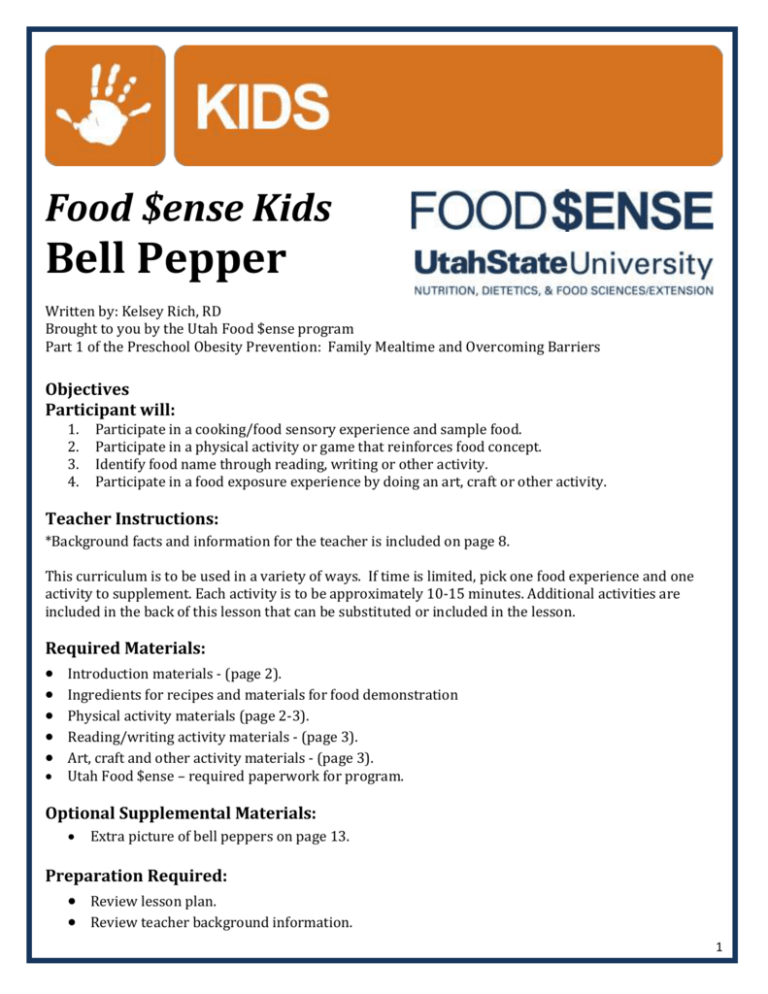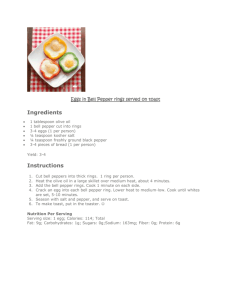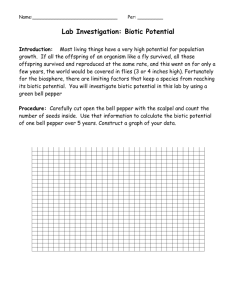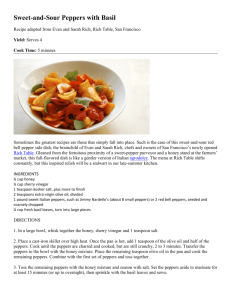Bell Peppers
advertisement

Food $ense Kids Bell Pepper Written by: Kelsey Rich, RD Brought to you by the Utah Food $ense program Part 1 of the Preschool Obesity Prevention: Family Mealtime and Overcoming Barriers Objectives Participant will: 1. 2. 3. 4. Participate in a cooking/food sensory experience and sample food. Participate in a physical activity or game that reinforces food concept. Identify food name through reading, writing or other activity. Participate in a food exposure experience by doing an art, craft or other activity. Teacher Instructions: *Background facts and information for the teacher is included on page 8. This curriculum is to be used in a variety of ways. If time is limited, pick one food experience and one activity to supplement. Each activity is to be approximately 10-15 minutes. Additional activities are included in the back of this lesson that can be substituted or included in the lesson. Required Materials: Introduction materials - (page 2). Ingredients for recipes and materials for food demonstration Physical activity materials (page 2-3). Reading/writing activity materials - (page 3). Art, craft and other activity materials - (page 3). Utah Food $ense – required paperwork for program. Optional Supplemental Materials: Extra picture of bell peppers on page 13. Preparation Required: Review lesson plan. Review teacher background information. 1 Chop bell peppers for introduction sensory activity. Gather ingredients and materials needed to demonstrate the recipes. Cut out bell peppers on page 7 for the “Pattern Pepper” worksheet. Make copies of recipes and take home messages handout you wish to distribute (see page 13) – enough for all class participants to take home to families. Make copies of all required paperwork for lesson. LESSON PLAN Introduction Time: 5 minutes Show children the pictures on page 9, 10, and 12 and ask children if they know what they are. Ask children: o How do bell peppers taste? Sweet and crunchy, not spicy o Have you eaten bell peppers before? o What colors can bell peppers be? Red, green, orange, yellow, purple, white, gold Red, yellow, and orange peppers are ripened green peppers. As the green pepper stays on the vine it changes colors and becomes sweeter. Bell peppers can be used with different foods….salads, raw, vegetable dips, stir fry, pasta, etc. Have children sample the yellow, orange, green, and red peppers. o Can they taste a difference? o Which one is sweeter? o What one was their favorite? Objective 1: Participate in a cooking/food sensory experience and sample food. Time: 15 minutes Choose a recipe that will work for your lesson: Kale and Pepper Pasta Roasted Peppers Simple Sautéed Peppers and Onions Objective 2: Participate in a physical activity or game that reinforces food concept. Time: 10 minutes Red pepper, green pepper o Play red pepper, green pepper (like red light, green light). o In a large room, have children line up against a wall. Stand across the room from the children. When you say “green pepper” and hold up a green pepper children can run towards you and when you say “red pepper” and hold up a red pepper children should stop. If a child doesn’t stop when “red pepper” is said, they must take two steps back. The first child to reach you gets to take your spot. Objective 3: Identify food name through a reading, writing or other activity. Time: 15 minutes Patterning o Choose a Pattern Peppers worksheet for the children based on their skill level. (Found on page 5 or 6). o Give each child a pattern worksheet and paper cut outs of peppers found on page 7. 2 (Optional: The children can also cut out their own pictures if desired.) o In the first section of the worksheet, have the children glue the match to the pattern in the boxes underneath the pattern. o In the second section: Option 1 (Page 5) : Have the children make up their own pattern. Have children glue their pattern in the boxes on the bottom of the page. Option 2 (Page 6): Have the children complete the pattern and glue their answers in the boxes. Objective 4: Participate in a food exposure experience by doing an art, craft, or other activity. Time: 10 minutes Have children color the coloring page (pg. 11) using the colors of bell peppers (red, green, orange, yellow). _____________________________________________________________________________ Conclusion: Time: 5 minutes What is it? Where does it grow? What can you make with it? What colors can a bell pepper be? How does it help your body? Discussion of food experience—What was your favorite part? Did you like the food? Resources : http://extension.usu.edu/fsne/htm/farmers-market-recipes -Kale and Pepper Pasta http://extension.usu.edu/admin/files/uploads/Viva%20Vegetables%20Pepper%20Recipes%20FINAL%20with% 20Photos.pdf –Southwestern Coleslaw Did you know? Bell peppers are really a fruit! They are high in vitamin A and contain more vitamin C than citrus fruits! Studies support the view that bell peppers have a protective effect against cataracts, rheumatoid arthritis, and lung cancer. This material was funded by USDA’s Supplemental Nutrition Assistance Program – SNAP. The Supplemental Nutrition Assistance Program (SNAP) provides nutrition assistance to people with low income. It can help you buy nutritious foods for a better diet. To find out more, contact 1-800-221-5689 or visit online at http://www.fns.usda.gov/snap/. In accordance with Federal Law and U.S. Department of Agriculture policy, this institution is prohibited from discriminating on the basis of race, color, national origin, sex, age, religion, political beliefs or disability. To file a complaint of discrimination, write USDA, Director, Office of Civil Rights, 1400 Independence Avenue, S.W., Washington, D.C. 20250-9410 or call (800)795-3572. 3 RECIPES TOPIC: Bell Peppers Kale and Pepper Pasta Ingredients: 12 oz. pasta (bow tie is great in this recipe) 1 tbsp olive oil 1 green bell pepper 1 red bell pepper 2 - 4 cups chopped kale 4 cloves garlic, minced 1 pinch dried or fresh basil 1 pinch ground cayenne pepper Salt and ground black pepper to taste Feta or parmesan cheese (optional) Directions: Bring a large pot of water to boil, add pasta and cook for 8 to 10 minutes. Heat oil in a skillet over medium heat. Stir in red and green pepper, kale and garlic. Season with basil, cayenne, salt and pepper. Cook until vegetables are tender. Toss pasta and vegetable mixture together and serve. Add some feta cheese crumbles or grated parmesan for an added zip (optional). Roasted Peppers Ingredients: 3-4 Red, Green and Orange Bell Peppers, cut into thin strips ¾ C Olive Oil 1 Clove garlic, minced 5 basil leaves, finely sliced ½ tsp. dried oregano Salt and pepper to taste Directions: Combine olive oil, garlic, basil, oregano, salt and pepper. Dip pepper strips in oil mixture, place on oiled pan over medium heat. Cook for 3-4 minutes or until tender. Simple Sautéed Peppers and Onions Ingredients: 1-2 T. Olive Oil 3-4 Red and Green bell peppers, stemmed, seeded, cut into thin strips 1-2 Large Onions cut into thin strips Salt and Pepper to taste Directions: Place oil in large, deep skillet and turn to medium high. One minute later add peppers and onions. Cook until peppers and onions are lightly browned and tender. Season with salt and pepper Can be added to pasta, fajitas, breakfast burritos, hamburgers, hot dogs, or as a side dish. This material was funded by USDA’s Supplemental Nutrition Assistance Program – SNAP. The Supplemental Nutrition Assistance Program (SNAP) provides nutrition assistance to people with low income. It can help you buy nutritious foods for a better diet. To find out more, contact 1-800-221-5689 or visit online at http://www.fns.usda.gov/snap/. In accordance with Federal Law and U.S. Department of Agriculture policy, this institution is prohibited from discriminating on the basis of race, color, national origin, sex, age, religion, political beliefs or disability. To file a complaint of discrimination, write USDA, Director, Office of Civil Rights, 1400 Independence Avenue, S.W., Washington, D.C. 20250-9410 or call (800)795-3572. 4 Patterning Peppers Can you match this pattern? Can you make your own pattern? 5 Patterning Peppers Can you match this pattern? Can you finish this pattern? 6 7 Preschool Curriculum Bell Pepper Facts Background Teaching Information Bell Pepper Nutrition Red bell peppers have more beta carotene and are more nutrient dense then their green counterparts. All bell peppers are high in vitamin C and Vitamin A, however red bell peppers contain more than twice as much vitamin C than green peppers. Red bell peppers have vitamin C content more than double than a large citrus fruit (orange). They also are a source of vitamin B6, folic acid, and fiber. Red peppers also contain lycopene, which has been show to reduce the risk of certain cancers (prostate cancer, cancer of the cervix, bladder, and pancreas). Studies support the view that bell peppers have a protective effect against cataracts, rheumatoid arthritis, and lung cancer. Uses Bell peppers are commonly used in Italian and Asian cuisines. The may be eaten cooked or raw. Fun Facts Bell peppers have no "bite" at all. They contain a recessive gene that eliminates capsaicin. Bell peppers have a mild tang and a crunchy texture that makes them suitable for eating raw. A bell pepper is a fruit, not a vegetable. The green pepper is the most common pepper sold in the United States. Bell Pepper Varieties Bell peppers can be found in a variety of colors including: green, red, yellow, orange, purple, gold, and white. The orange, yellow, and red peppers are ripe versions of the green pepper. As bell peppers ripen on the vine, they become red and have a sweeter taste. Growing Cycle Today, bell peppers are primarily grown in China, Turey, Spain, Romania, Nigeria, and Mexico. However, they are also found in California, New Jersey, and Florida. They are sensitive to extreme temperatures (>100°F). They grow in climates with day temperatures between 75-85° F and night temperatures of 1520°F. The bell pepper is generally harvested green before maturing to a different color. Resources: 1. 2. 3. 4. http://www.dole.com/SuperKids/Encyclopedia/Facts/tabid/831/Default.aspx?contentid=2509). http://en.wikipedia.org/wiki/Bell_peppers http://www.newworldencyclopedia.org/entry/Bell_pepper http://www.marylandpublicschools.org/NR/rdonlyres/3DE1552A-7CD1-48C1-B0C5569F27B6B958/6251/1swbellpeppersflyer.pdf 5. http://www.extension.iastate.edu/healthnutrition/foodrecipeactivity/food/bell_pepper.htm 6. 7. This material was funded by USDA’s Supplemental Nutrition Assistance Program – SNAP. The Supplemental Nutrition Assistance Program (SNAP) provides nutrition assistance to people with low income. It can help you buy nutritious foods for a better diet. To find out more, contact 1-800-221-5689 or visit online at http://www.fns.usda.gov/snap/. In accordance with Federal Law and U.S. Department of Agriculture policy, this institution is prohibited from discriminating on the basis of race, color, national origin, sex, age, religion, political beliefs or disability. To file a complaint of discrimination, write USDA, Director, Office of Civil Rights, 1400 Independence Avenue, S.W., Washington, D.C. 20250-9410 or call (800)795-357 8 RED PEPPER 9 GREEN PEPPER 10 Bell peppers are BRIGHT and COLORFUL… 11 RED, YELLOW, ORANGE, GREEN! 12 13





